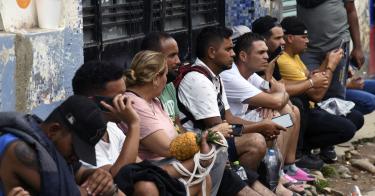The first Summit of the Americas hosted in the United States since 1994 was by most accounts a wet firecracker. The White House followed that dud by announcing the “Los Angeles Declaration on Migration and Protection”—a nothing-burger charitably described by Politico as a “non-binding migration blueprint.”
The announcement framed the declaration as “bold,” using the word twice in the opening section (“bold actions” and “a suite of bold new migration-related deliverables”). What’s bold about them is that the Biden administration is now creating yet more “legal pathways” for people to enter and remain in this country, while still keeping the border open for illegal entry. Focused on assisting migrants and the countries they come from and pass through, the declaration says nothing about trying to stop the uncontrolled flow crossing our southern border.
Concerning the estimated 5 million Venezuelans who have already fled the Maduro regime’s oppression and economic mismanagement, the declaration states that Columbia will grant up to 1.5 million “regularization permits.” Ecuador will do something similar for a smaller number. Costa Rica will extend temporary status for refugees from Venezuela, Nicaragua, and Cuba, and tiny Belize promises to regularize a number of illegally-present Central Americans and Caribbeans there. As for the United States, we will provide $25 million to a World Bank program and $314 million in foreign aid to assist other countries’ legalization efforts.
To “change the way people migrate,” the declaration vows to “expand legal pathways.” What this means in practice is letting more people in legally while legalizing those present illegally. For its part, Canada will take in up to 4,000 refugees by 2028. (For perspective, that’s about half the number of people crossing illegally into the U.S. each day.) More significantly, Canada will allow in 50,000 agricultural workers from Mexico, Guatemala, and the Caribbean this year. Ottawa also agreed to invest $26.9 million toward vague goals like “migration and protection related capacity building,” while advancing “gender equality and inclusive economic growth.” Mexico will allow up to 40,000 more temporary workers from countries to its south and integrate 20,000 more refugees. Collectively, this is not exactly game-changing.
There are no guarantees that any of the Central American or Caribbean migrants given temporary refuge by countries to our north or south won’t later decide to try their luck crossing into the United States. This happened last fall when about 15,000 illegal aliens massed under the Del Rio International Bridge. Many were Haitians who had already been resettled by other countries such as Costa Rica, but the Haitians ditched their resettlement documents to pursue asylum here. Migrants who have been safely resettled elsewhere and then try to enter the United States illegally should be returned to that third country and barred for a determined period from seeking any immigration benefits in the United States.
No such restriction appears in the declaration. Instead, it commits the United States to spend $65 million “to support U.S. farmers hiring agricultural workers under the H2A program,” then promises (an already promised) 11,500 H-2B non-agricultural seasonal worker visas for Central Americans and Haitians. The United States will also issue guidance on Fair Recruitment Practices in cooperation with major U.S. employers such as Walmart.
In the Los Angeles Declaration, the United States commits to resettling 20,000 refugees from the Americas over the next two years: that’s roughly the number of illegal crossers U.S. Customs and Border Protection officers encounter every three days. The United States will also “increase settlement of Haitian refugees,” without specifying a number. Unfortunately, these various increases to the legal pathways are not balanced by any effort to make illegal immigration less attractive. They are unlikely to divert the latest mass “caravan” of migrants, many thought to be from Venezuela, that was headed north to our border even as the conference was taking place.
The declaration also includes the administration’s previously announced plan to restart the Haitian and Cuban Family Reunification Parole Programs. This means that, instead of waiting their turn back home like Indian, Chinese, or Mexican relatives of U.S. citizens, the Cubans and Haitians will get to live and work here while they “wait.” With twenty-year-plus waiting times for many family members following the legal path, Filipinos will wish their islands were closer to Florida.
The declaration’s final section, “humane border management,” comprises only a “multilateral Sting Operation” as part of ongoing efforts to catch human traffickers, who the Biden administration’s own policies are in fact enriching and multiplying, and a contentious change to the asylum process that critics have slammed as illegal, inefficient, and designed to circumvent proper scrutiny of asylum applications.
>>> Biden’s Open Border Is an Open Invitation to Terrorist Attacks
In short, the declaration does nothing to address the core problem: zero enforcement at our border, which sends a clear signal to smugglers and would-be migrants across the Americas and the Caribbean that our door is wide open. The Biden practice is to allow most illegals to enter, ship them into the interior, and grant them parole until their asylum cases can be adjudicated. With massive backlogs in processing both asylum applications (over 432,000 applications pending at USCIS) and all types of legal immigration benefit applications (over 8.4 million pending), this means that illegal entrants are de facto immigrants, with access to work, education, and other advantages unavailable to most legal visitors. In addition, their presence seriously prolongs the wait time for applicants in the legal immigration line.
The promises made by U.S. and other North and Central American governments in the declaration are dwarfed by the scale of the current migration wave, which is caused by political, economic, and other factors beyond their control. Unless the United States wants to accept unlimited, unregulated immigration forever, at some point our government will have to enforce our laws instead of seeking the chimera of even more “legal pathways” to absorb the endless flow.
This piece originally appeared in The National Interest https://nationalinterest.org/feature/los-angeles-declaration-bad-news-us-border-203083




